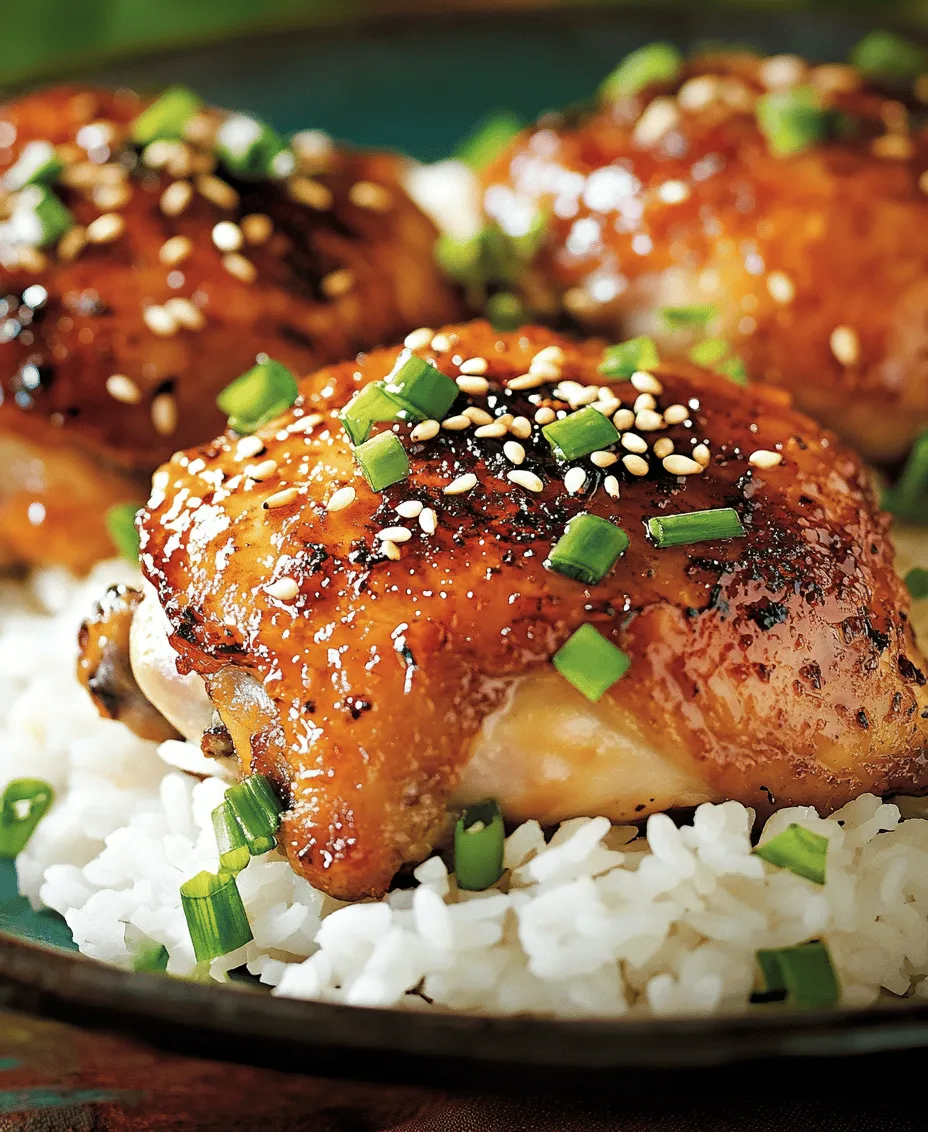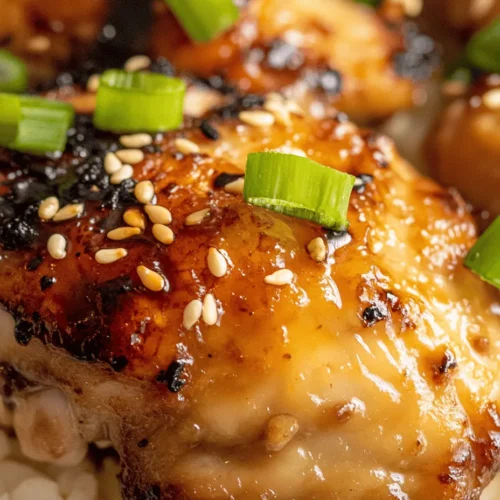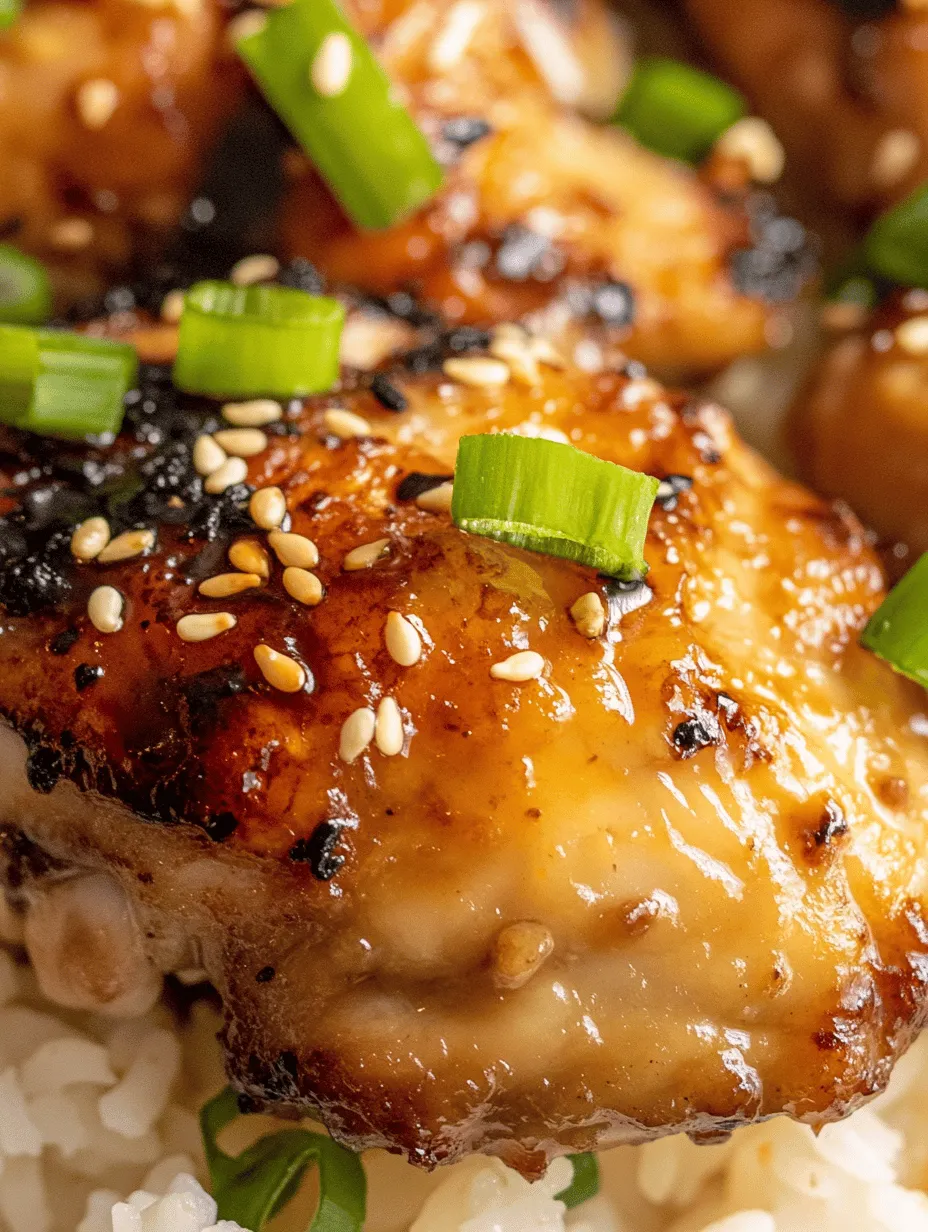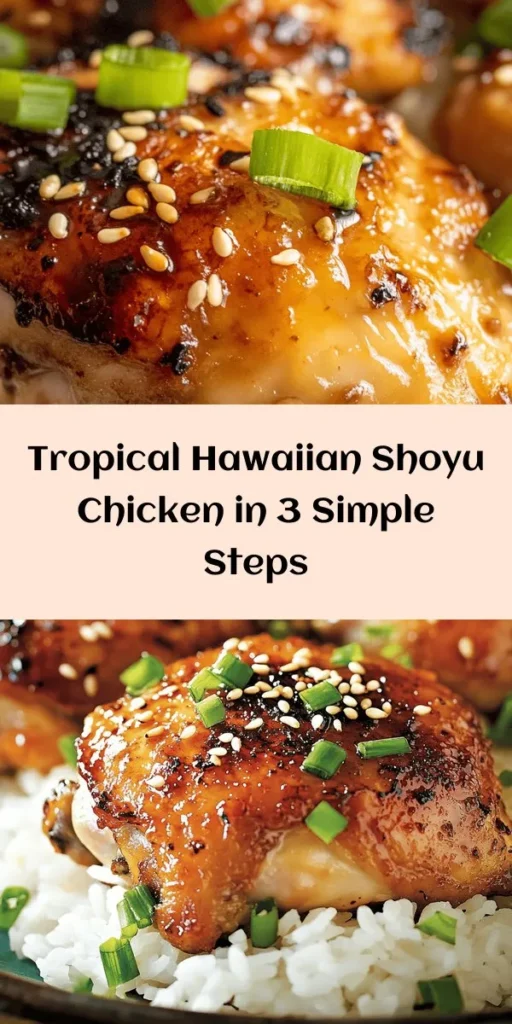Hawaiian Shoyu Chicken is a delightful dish that encapsulates the essence of the islands, offering a unique blend of savory, sweet, and aromatic flavors that transport your taste buds straight to a tropical paradise. This dish is a culinary gem that highlights the beautiful fusion of Hawaiian, Asian, and American influences, making it a staple in many households across Hawaii and beyond. At the heart of Hawaiian Shoyu Chicken is the harmonious combination of soy sauce, brown sugar, garlic, and ginger, which creates a mouthwatering glaze that caramelizes beautifully during cooking.
What makes Hawaiian Shoyu Chicken particularly appealing is not just its flavor profile but also its simplicity. The recipe is straightforward, making it an excellent choice for busy weeknight dinners or special occasions where you want to impress your guests without spending hours in the kitchen. The balance of sweet and savory, combined with the tender juiciness of chicken thighs, makes this dish a crowd-pleaser that everyone will love.
Understanding Hawaiian Cuisine
To fully appreciate Hawaiian Shoyu Chicken, it’s essential to delve into the rich tapestry of Hawaiian cuisine. The food culture in Hawaii is a true melting pot, influenced by the native Hawaiian traditions and the waves of immigrants from Asia, Europe, and the Americas. This culinary fusion has resulted in a diverse array of flavors and dishes that reflect the islands’ history and multicultural heritage.
Traditional Hawaiian cuisine is centered around fresh, local ingredients, with taro, fish, and tropical fruits playing significant roles. The influence of Asian cooking is profound, with dishes often featuring soy sauce, rice, and a variety of spices. The introduction of soy sauce to Hawaiian cooking can be traced back to Chinese immigrants, who brought their culinary practices to the islands. Over time, this savory condiment has become a staple in many Hawaiian dishes, including our focus today—Hawaiian Shoyu Chicken.
In addition to soy sauce, other ingredients commonly used in Hawaiian cuisine include rice vinegar, which adds acidity and balances the flavors in dishes, and a variety of fresh herbs and spices that enhance the overall taste. Understanding these elements provides a deeper appreciation for Hawaiian Shoyu Chicken and the thoughtful way in which flavors are developed in Hawaiian cooking.
Key Ingredients for Hawaiian Shoyu Chicken
To create a delicious batch of Hawaiian Shoyu Chicken, it’s important to understand the key ingredients that contribute to its unique flavor profile. Each component plays a crucial role in building the dish’s rich taste and aromatic quality.
Chicken Thighs
The primary protein in Hawaiian Shoyu Chicken is chicken thighs, specifically bone-in, skin-on thighs. This choice is significant for a couple of reasons. First, chicken thighs are known for their rich flavor and tenderness. The higher fat content compared to chicken breasts ensures that the meat remains juicy throughout the cooking process, which is essential for a dish that relies on caramelization and sauce. The skin also contributes to the overall texture and flavor, as it crisps up beautifully during cooking, providing a satisfying contrast to the tender meat beneath.
Soy Sauce
Soy sauce is a cornerstone of this recipe, providing the essential umami flavor that characterizes many Asian dishes. When selecting soy sauce for Hawaiian Shoyu Chicken, you may encounter both regular and low-sodium varieties. Regular soy sauce delivers a robust flavor, while low-sodium soy sauce allows for more control over the saltiness of the dish. Depending on your preference and dietary needs, either option can be used effectively in the marinade, adding depth and richness to the overall flavor profile.
Brown Sugar
Brown sugar is another key ingredient that sets Hawaiian Shoyu Chicken apart. Its natural sweetness balances the saltiness of the soy sauce, creating a harmonious blend of flavors. When brown sugar is heated, it caramelizes, resulting in a glossy, sticky sauce that clings beautifully to the chicken. This caramelization process not only enhances the dish’s sweetness but also adds a complex layer of flavor that elevates the overall experience.
Rice Vinegar
Adding rice vinegar to the marinade is essential for achieving a well-rounded flavor profile. The light acidity from rice vinegar serves to cut through the richness of the chicken thighs and balances the sweetness from the brown sugar. It brightens the dish, ensuring that the flavors do not become overly heavy. Rice vinegar is a common ingredient in many Asian cuisines, and its inclusion in Hawaiian Shoyu Chicken reflects the dish’s cultural roots.
Garlic and Ginger
The dynamic duo of garlic and ginger is crucial for adding depth and aroma to the dish. Garlic brings a pungent, savory note, while ginger offers a warm spice that complements the other flavors beautifully. Both ingredients are also known for their health benefits, including anti-inflammatory properties and digestive support, making them a smart addition to any meal. Their vibrant flavors enhance the marinade, contributing to the overall complexity of the dish.
Sesame Oil
A drizzle of sesame oil rounds out the flavor profile of Hawaiian Shoyu Chicken. Known for its aromatic qualities, sesame oil adds a nutty richness that ties the other ingredients together. It’s a common ingredient in Asian cooking, and its presence in this recipe further highlights the cultural influences at play. A little goes a long way, so just a small amount is needed to impart its distinctive flavor.
Optional Ingredients
While the core ingredients of Hawaiian Shoyu Chicken are enough to create a delicious dish, you can also customize it to suit your taste preferences. One popular addition is red chili flakes, which can be added to the marinade to give the dish a bit of heat. This optional ingredient allows you to adjust the spice level according to your family’s preferences, making the recipe versatile and adaptable.
Preparing the Marinade: Building Flavor
Now that we’ve explored the key ingredients for Hawaiian Shoyu Chicken, it’s time to discuss the all-important step of preparing the marinade. The marinade not only infuses the chicken with flavor but also helps to tenderize the meat, ensuring a juicy and delicious result when cooked.
To begin, combine the soy sauce, brown sugar, rice vinegar, minced garlic, grated ginger, and sesame oil in a mixing bowl. Whisk these ingredients together until the sugar is fully dissolved and the marinade is well blended. The combination of savory, sweet, and tangy notes will create a flavor base that is truly irresistible.
For those who enjoy a bit of spiciness, this is the moment to sprinkle in some red chili flakes, tailoring the heat level to your liking. Once your marinade is ready, you can add the chicken thighs, ensuring that each piece is well coated in the flavorful mixture.
For optimal results, consider marinating the chicken for at least 30 minutes, though longer is even better if you have the time. A couple of hours or even overnight in the refrigerator will allow the flavors to penetrate the meat deeply, resulting in a more robust and satisfying dish.
Once the chicken has marinated, it’s ready to be cooked, and you’ll soon find yourself savoring the delicious aromas wafting through your kitchen as it transforms into a succulent meal that embodies the spirit of Hawaii. This straightforward yet flavorful recipe is sure to become a staple in your culinary repertoire, bringing a taste of the islands to your dining table.

Marinating the Chicken: Timing is Key
The marination process is a crucial step in crafting Hawaiian Shoyu Chicken. It’s during this time that the chicken absorbs the flavors of the marinade, which is a harmonious blend of soy sauce, garlic, ginger, and sweet elements like brown sugar and pineapple juice. Allowing the chicken to soak in this mixture not only enhances its taste but also tenderizes the meat, making it juicier and more flavorful.
Recommended Marinating Times
– Two Hours: If you’re short on time, marinating the chicken for two hours is still effective. This duration allows the marinade to penetrate the surface of the chicken, providing a decent flavor boost. However, the deeper infusion of flavors may not occur as significantly as with longer marination.
– Overnight: For the best results, marinate the chicken overnight. This extended period gives the flavors ample time to soak into the meat, resulting in a more robust taste. The science behind marinating reveals that the acid in the marinade helps to break down protein fibers, making the chicken more tender while simultaneously enhancing its flavor profile.
Personalizing Your Marinade
Adjusting the marinade to suit your taste is simple and encouraged. Here are some tips to customize your Hawaiian Shoyu Chicken marinade:
– Sweetness: If you prefer a sweeter taste, add more brown sugar or honey. Conversely, reduce the sweet components for a more savory flavor.
– Spiciness: Introduce some heat by adding red pepper flakes or a dash of sriracha for those who enjoy a spicy kick.
– Umami Boost: Experiment with adding oyster sauce or miso paste to increase the umami flavor that complements the soy sauce.
Cooking Techniques for Perfect Hawaiian Shoyu Chicken
Once the chicken has marinated, the next step is cooking it properly to achieve that delicious, authentic Hawaiian flavor. Here are two key techniques: searing and baking.
Searing
Searing the chicken is an essential technique for creating depth of flavor and a delightful texture. Here’s how to do it effectively:
1. Preheat Your Pan: Start by heating a skillet over medium-high heat. Ensure your pan is hot before adding the chicken; this will help to achieve that coveted golden-brown crust.
2. Skin-Side Down: Place the chicken skin-side down in the hot skillet. This method allows the fat from the skin to render out, enhancing the flavor and giving it a crispy texture.
3. Avoid Overcrowding: If you’re cooking multiple pieces, do not overcrowd the pan. This can lower the temperature and result in steaming rather than searing.
4. Perfect Golden-Brown Crust: Allow the chicken to cook undisturbed for about 5-7 minutes. Resist the urge to move it around; letting it sit will help develop a beautiful crust. Flip the chicken once the skin is perfectly browned.
Baking
After searing, transferring the chicken to the oven ensures even cooking and moisture retention. Here’s how to properly bake your Hawaiian Shoyu Chicken:
1. Preheat the Oven: Set your oven to 375°F (190°C) for optimal cooking conditions.
2. Transfer to Baking Dish: After searing, place the chicken in a baking dish, skin-side up, and pour any remaining marinade over the top.
3. Cook Until Done: Bake the chicken until it reaches an internal temperature of 165°F (74°C). This usually takes about 25-30 minutes, depending on the size of the chicken pieces.
4. Resting Time: Allow the chicken to rest for about 5-10 minutes after taking it out of the oven. This step is crucial, as it helps the juices redistribute throughout the meat, ensuring each bite is succulent.
Garnishing and Serving Suggestions
The presentation of your Hawaiian Shoyu Chicken can elevate the dish from simple to stunning. Here are some creative ideas for serving:
Rice Pairings
Hawaiian Shoyu Chicken pairs beautifully with rice, acting as the perfect base to soak up the savory sauce. Consider these options:
– Jasmine Rice: Its floral aroma and slightly sticky texture complement the flavors of the chicken and sauce exceptionally well.
– Basmati Rice: With its nutty flavor and fluffy texture, basmati rice adds an elegant touch and balances the dish nicely.
– Coconut Rice: For a tropical twist, prepare coconut rice by cooking jasmine rice in coconut milk. This will add a creamy and sweet element that enhances the Hawaiian theme.
Garnishes
Garnishing your dish not only boosts visual appeal but also enhances flavor. Here are some suggestions:
– Green Onions: Chopped green onions add a fresh crunch that contrasts beautifully with the tender chicken.
– Sesame Seeds: Sprinkle toasted sesame seeds on top for an additional nutty flavor and a touch of elegance.
– Pineapple: Fresh pineapple chunks can be added for a burst of sweetness, echoing the tropical flavors of the marinade.
– Cilantro: A sprinkle of fresh cilantro can bring a refreshing herbaceous note to the dish, balancing the richness of the chicken.
Nutritional Information: A Healthier Choice
Hawaiian Shoyu Chicken is not only delicious but also offers several nutritional benefits:
– Protein Content: Chicken is an excellent source of lean protein, essential for muscle repair and overall health.
– Vitamins and Minerals: The marinade ingredients, including garlic and ginger, provide antioxidants and anti-inflammatory properties, contributing to a healthy diet.
– Low in Carbohydrates: When served with rice, this dish remains relatively low in carbohydrates, making it suitable for various dietary preferences.
Dietary Modifications
For those with specific dietary needs, consider these modifications:
– Gluten-Free: Use tamari instead of soy sauce to create a gluten-free version of this dish. This alternative maintains the same savory flavor without the gluten content.
– Low-Sodium: Opt for low-sodium soy sauce to reduce sodium levels without sacrificing taste.
Conclusion: Bringing Hawaiian Flavors Home
Preparing Hawaiian Shoyu Chicken at home is a delightful culinary experience that brings the exotic flavors of Hawaii right to your dining table. The combination of savory, sweet, and tangy notes creates a dish that is not only satisfying but also incredibly versatile. Whether you serve it with rice, garnish it with fresh herbs, or enjoy it straight from the oven, this dish embodies the essence of island cuisine.
By embracing the process of marinating and cooking with care, you’ll discover the joy of Hawaiian flavors in your own kitchen. So, gather your ingredients, invite your friends and family, and celebrate the art of homemade cooking with this delectable recipe. Enjoy the taste of the islands and the satisfaction that comes from creating a meal that delights both the palate and the heart.



